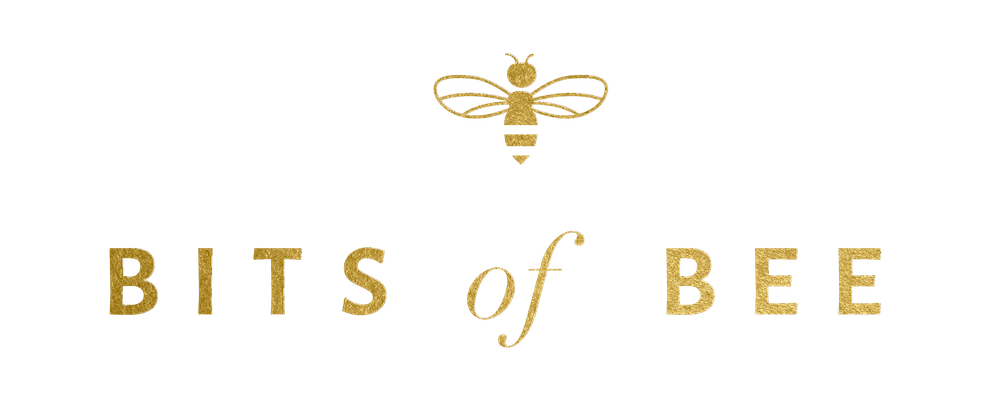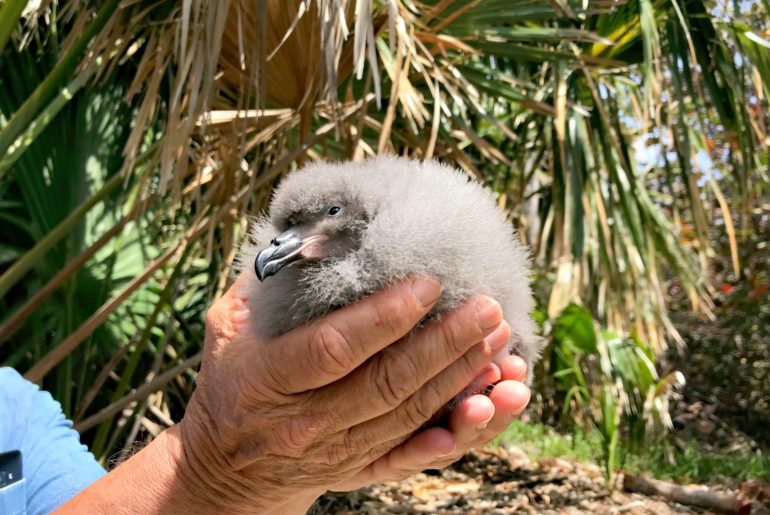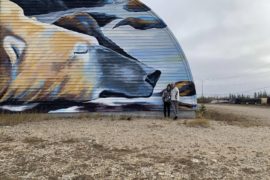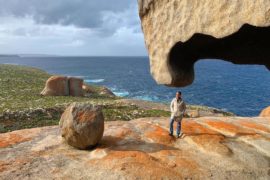Long thought to be extinct, the Bermuda Petrel is slowly recovering—with a little help from its human friends.
Water splashes over my lap as our small white boat bounces over the furious waves that surround Nonsuch Island. We’re within the Castle Harbour Islands Nature Reserve only minutes from the shores of Bermuda’s mainland.
This is usually a calm coastal commute, but a recent storm has resulted in rough waters, nearly causing our excursion to get cancelled. I’m with a small group of journalists and scientists, heading to Nonsuch Island on a bucket-list journey for birding enthusiasts. But it’s a way-out-of-my-comfort-zone trek for me because, honestly, I have a fear of close-up interactions with birds.
I don’t mind the sprays of the cyan water on my face, as it keeps me cool while the sun beats heat onto the back of my neck. As we navigate the short distance from the mainland to the private island, our guide shares the backstory of Bermuda’s conservation efforts, and how the recolonization of the Cahow came to be. The species is known to science as the Bermuda Petrel, Pterodroma cahow, but it is widely referred to as the Cahow, in reference to the bird’s strange call.
Jean-Pierre (“JP”) Rouja, in addition to being a photographer, is Nonsuch Expeditions Team Leader and Sargasso Sea Commission Ambassador. He begins the boat ride by describing his involvement in the project.
“Nonsuch Expeditions is a project where we’re showcasing the conservation efforts that are happening on the island,” begins JP, his voice sturdy as our boat bumps up and down on the waves. “We’re using it as a lens through which to showcase Bermuda’s biodiversity. We’re not putting this forward as an ecotourism destination for your average cruise ship passenger, because that’s not what Nonsuch is.”
His voice takes on a more serious tone.
“It’s a very successful nature reserve, and because of that, it’s extremely sensitive, so we just can’t put the foot traffic through there. For this reason, we limit it to small exclusive groups, and local students for whom the experience can be transformational.”
I’m starting to appreciate just how exclusive and unique this opportunity is for our group. I’m about to be one of only two Canadian journalists to see the Cahow up close, and while my apprehension about live birds persists, my curiosity calms my nerves.
JP’s voice shifts to a friendlier tone.
“I started working out there about 20 years ago now with my filmmaker hat on; I was working on a story on the translocation process, shadowing and following Jeremy,” he explains.
The Jeremy of whom he speaks is Jeremy Madeiros, Senior Terrestrial Conservation Officer and the lead scientist with the Cahow recolonization efforts. Jeremy is to meet us when we arrive at Nonsuch Island.
JP goes on to explain the challenges he faced when trying to set up the live “Cahow cam,” which has streamed over 15 million minutes of video since its installation. For starters, he had to find lights that can film clearly while keeping the inside of the nests completely dark; it was a difficult feat, but well worth it.
“Now we have people watching from around the world as the chicks hatch,” JP enthuses. “It’s such an incredible outreach tool for people to keep in the loop on what’s happening here.”
The boat turns a sharp corner, and there, standing on a small dock at the base of a rocky cliff, stands Jeremy, waving vigorously as our boat approaches. Nonsuch Island is unlike any place that I’ve visited during my travels. From afar, it looks like an average dot in an oceanic archipelago; but when you’re there, it’s revealed as so much more.
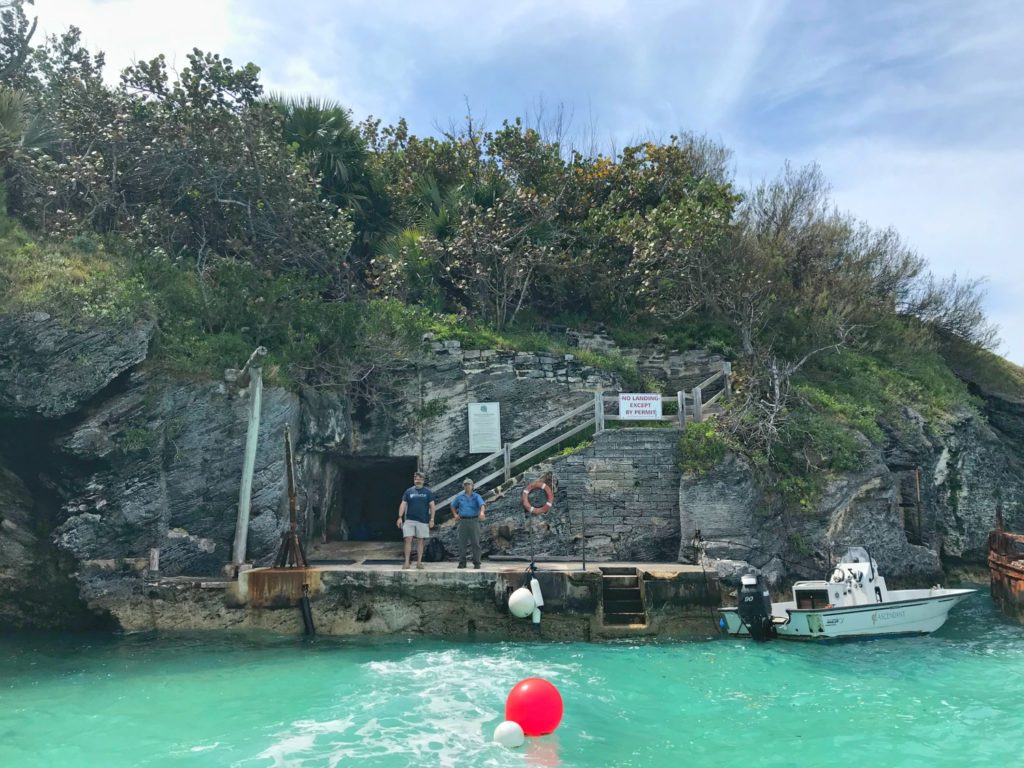
The island is effectively managed under a stringent biological quarantine. As you step off the boat, you scrub your shoes on bleach-doused mats. Scientists have found that things packed in the tread of people’s boots have introduced exotic species to the island. It’s amazing how we bring in dirt containing planarian flatworms and even earthworms that sterilize soils and put native endangered species at risk. We are asked to arrive empty-handed, and to tread carefully.
After a short briefing, we head up some stone steps, following Jeremy through the brush and into a small hut.
“Nonsuch is like no other place,” he intones, as though reading the opening line of a fairytale. “It is managed totally for the wildlife, especially the island’s most endangered flora and fauna. Several ‘Lazarus species’ can be found on the island—species that were thought to be extinct, but then were rediscovered, in some cases, like the Cahow, over 300 years later.”
There is more to Nonsuch than the Cahow. More than 7,000 plant and animal species share Bermuda with the people who call the archipelago home, many of which inhabit the 18 different islands that make up Castle Harbour Islands Nature Reserve. Jeremy and his team have made it their mission to maintain the entire ecosystem.
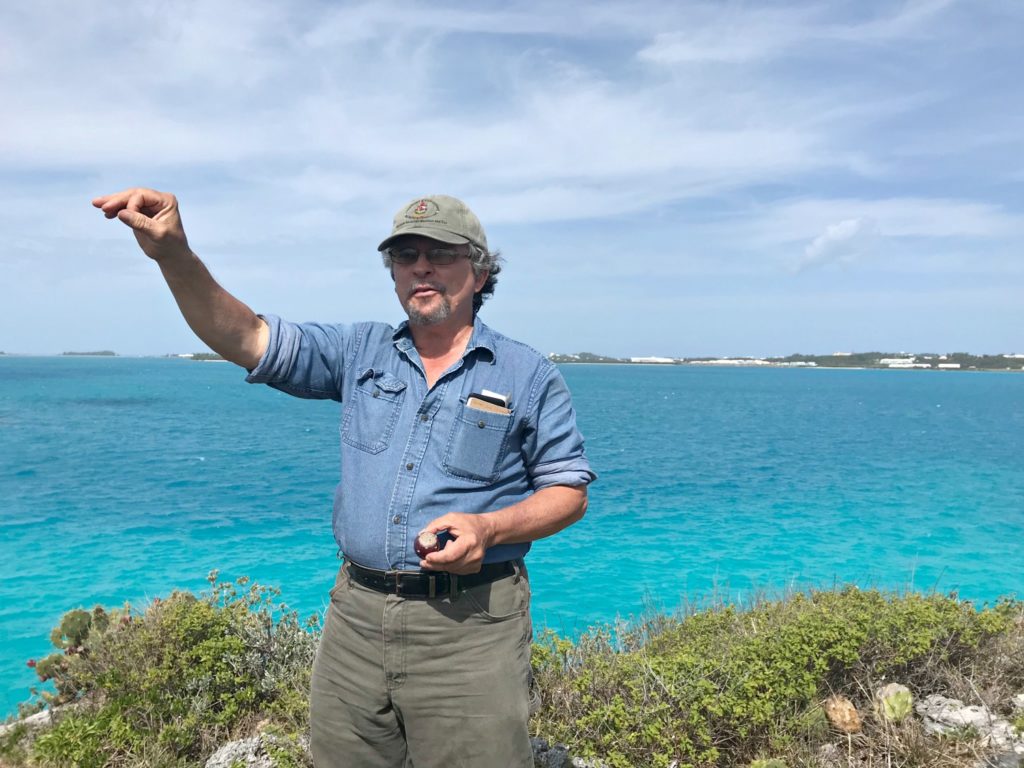
His overview of the matter: “This is an amazing multidisciplinary restoration attempt. It’s one of the earliest examples of ecological restoration anywhere, having started in the 1960s—back when the management of endangered species focused on breeding in captivity, back when it was thought impossible to restore an entire ecosystem. This was a fairly simple ecosystem, so it was the perfect laboratory to attempt a new approach. It has worked, and it’s been successful beyond our wildest dreams.”
Then he dives into how he got involved in this important project.
Jeremy began as an apprentice in 1984, working with a team of scientists on Nonsuch Island to help with their conservation efforts. At the time, the team was led by David Wingate, who had initiated a “Living Museum” project in 1963. The work had begun with a massive native reforestation project, in which 18,000 native plants were brought to the island. Two artificial ponds were created: a freshwater lagoon and a salt marsh. During this time, several indigenous species were successfully introduced to the island, including the Night Heron, Killifish, and West Indian Top Shell.
Prof. Wingate was one of the earliest naturalists to study the recently rediscovered Cahow. When he was a 15-year-old schoolboy and naturalist, he accompanied Robert Cushman Murphy of the American Museum of Natural History and Louis B. Mowbray of the Bermuda Aquarium, on an early excursion to the Castle Harbour Islands, where they came across the Cahow nesting in very small numbers on one of the outlying islands.
With its larger size and higher elevation, Nonsuch was an ideal location for keeping the Cahow from going extinct. It was also seen as a possible future site for relocation of Cahows from elsewhere. The Living Museum was up and running.
In 2000, Prof. Wingate retired, and Jeremy took over as Project Lead and Warden for Nonsuch Island. Jeremy’s first priority, due to the continuing hurricane-impacted erosion of the smaller nesting islets, was to explore ways to expand the Cahow nesting colony on Nonsuch. So he traveled to Australia to learn about new techniques being used on established seabird colonies, as well as to receive training in the handling, moving, and management of seabird colonies. Jeremy decided to attempt translocation back in Bermuda.
Translocation begins with monitoring the growth of chicks from practically the moment of hatching. Hatchlings are moved at a specific time in their development from the original nesting islets to a complex of new artificial nests. They are then handfed and allowed to imprint on the new site before fledging and dispersing at sea; this is accomplished by letting the birds out at night so that they can take stock of their surroundings. The hope is that they will return to the same spot years later.
The first successful translocation of the Cahow was completed in 2004, when 14 chicks were moved from their original islets to artificial burrows constructed on Nonsuch, where Cahows bred in tremendous abundance before the 1620s. Each burrow required more than 600 pounds of concrete. The artificial nests were fitted with thick concrete lids for easy access by scientists, elbows in the tunnel to ensure complete darkness for the nestlings, and openings near the ground for the birds to enter and exit.
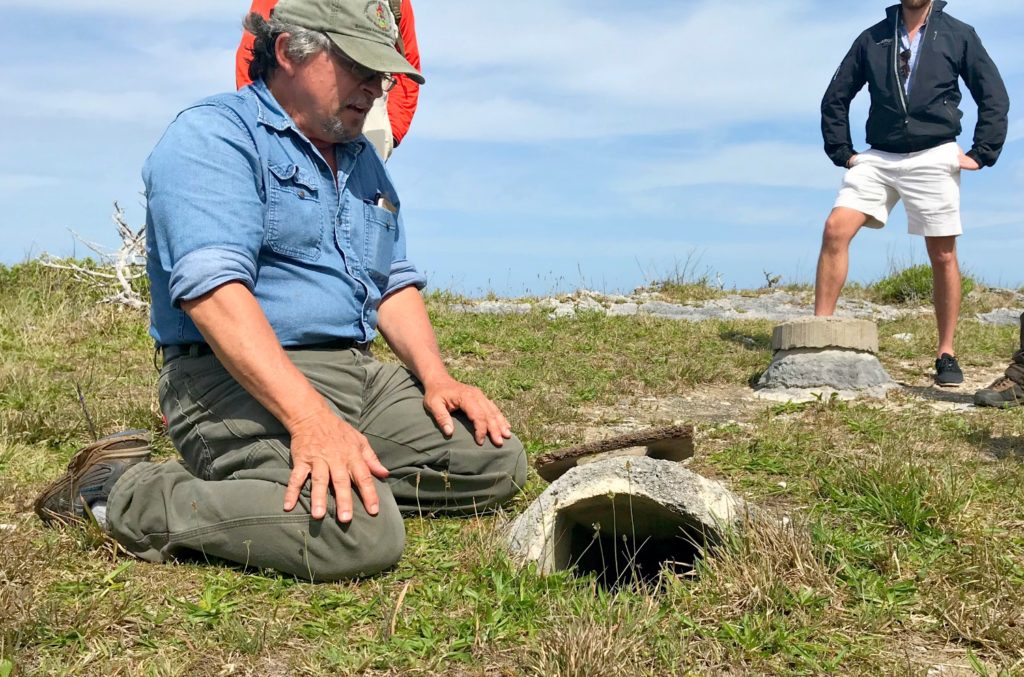
An immediate challenge with the humanmade burrows was that White-tailed Tropicbirds, known locally as Longtails, were finding their way into this “free housing,” killing the Cahow chicks, and usurping their living quarters. The two species’ breeding seasons overlap, and, in the early years of the translocation project, scientists lost a third of the Cahow population to tropicbirds.
To address this issue, Jeremy built wooden boards with small openings that Cahows can fit through—but that tropicbirds cannot. Some 170 custom-cut covers were placed around the island at the entrance of each nest, ensuring the safety of the Cahow chicks against the tropicbirds.
Once the Cahow chicks were relocated to the humanmade burrows, they were handfed squid and anchovies. Their growth and development were carefully monitored by Jeremy and his team, until all the chicks successfully fledged to sea two to three weeks later. The success rate was 100%!
Related: Cave, Cycle, and Catamaran – Explore Bermuda
Over the next five years, 105 chicks were successfully translocated, of which 102 (>95%) fledged out to sea. Beginning in the seventh and eighth years of the undertaking, the first set of chicks returned to the island and had their own chicks there. The translocation was, by all counts, a success.
Before we head out to see the artificial burrows and meet the latest batch of newborn chicks, Jeremy shares a little background about how Nonsuch Island came to be the acclaimed conservation accomplishment that it is today.
Nonsuch Island: Natural and Human History
Nonsuch Island is only 16.5 acres (6.7 hectares) in size, but it has a lot of history. The island was named by Sea Venture shipwreck survivors, exploring the area in 1609. They were on the island for over nine months, and fell in love with its evocative landscape, with a thick forest of juniper (“cedar”), perfect for building, and palmetto palms, an important food source. They enjoyed close access to the best fishing grounds in Bermuda, and the soil was good for farming. Also advantageous was that the island is near one of only two natural entrances through the reef line into a sheltered anchorage in the nearby Castle Roads channel. Although low-lying of course, the island was nevertheless of sufficient stature for building homes and other structures that would withstand flooding during hurricanes. And the flat, sandy beaches were ideal for landings by boat.
According to Jeremy, the first settlers of Nonsuch have had an important impact on today’s conservation efforts.
“Luckily for us and for the work that we’re doing to restore the environment, the ship had the governor on board, it had the admiral, and all the official record keepers,” he tells us. “They left several very detailed accounts of the island and its animal life, the geology, the plants, and even which plants had value as timber and such because they built two ships using some of the cedar trees to get off the island. The accounts were so detailed—especially observations of the Cahow—that they’ve provided the framework for us to do our work.”
The island is said to have been named after Nonsuch Palace in Surrey, England—one of the first modern wood palaces. Legend has it that settlers landed on the island and declared, “There is nonsuch like it in the rest of the Bermudas.” The name stuck.
Related Story: Beyond The Beaches Of Bermuda (NUVO)
Since its discovery by Europeans, Nonsuch has been put to various uses—as a privately owned farm, even as an off-island reform school for boys. Between 1934 and 1948, it was a minimum-security prison for delinquent boys guilty of petty crimes like stealing bicycles. Rather than being thrown in jail with hardened criminals, the boys were brought to the island for six months to two years. The facility was staffed by former army sergeants, and its goal was to teach boys how to take care of the reform school, while learning life skills like masonry, carpentry, plumbing, and farming.
Of the early days of Nonsuch Island, Jeremy offers a personal reflection: “My first ever recollection of Nonsuch was one time when I was misbehaving in my parents’ car. I must have been about four or five years old, and I was arguing with my sister, a couple of years older than I. We were on the causeway where you can see Nonsuch in the distance, and my father warned, ‘If you don’t behave, I’m going to send you to Nonsuch Island.’”
Jeremy chuckles.
“Little would I have known that a sort of nightmare would have become my dream,” he muses.
Meet the Cahow Hatchlings
We continue our trek through the arborous arches toward the other end of the island where the humanmade burrows are set up. As we approach, Jeremy turns to us and asks us to tread lightly and keep our voices to a whisper. We were nearing the nursery of the newly hatched Cahow chicks, and we didn’t want to disturb them.
We cross the threshold into the nesting area, and Jeremy’s demeanor becomes focused and serious. He’s at work now. His priorities have shifted entirely to the Cahow chicks.
In complete silence, we watch as Jeremy comes the circular cement lid—designed to cover the underground nest and provide complete darkness for the hatchling. I can tell that it’s heavy as Jeremy heaves it off to the side, and reaches deep into the dark hole. His fingers outstretched, he grasps into the darkness, pauses for a moment, and then lifts his arm back out. In his hand, he holds a fluffy ball of a baby bird, its eyes blinking as it looks around.
“This is Spirit,” Jeremy whispers as he outstretches his arm toward us for a better view. Cameras and smartphones are clicking away.
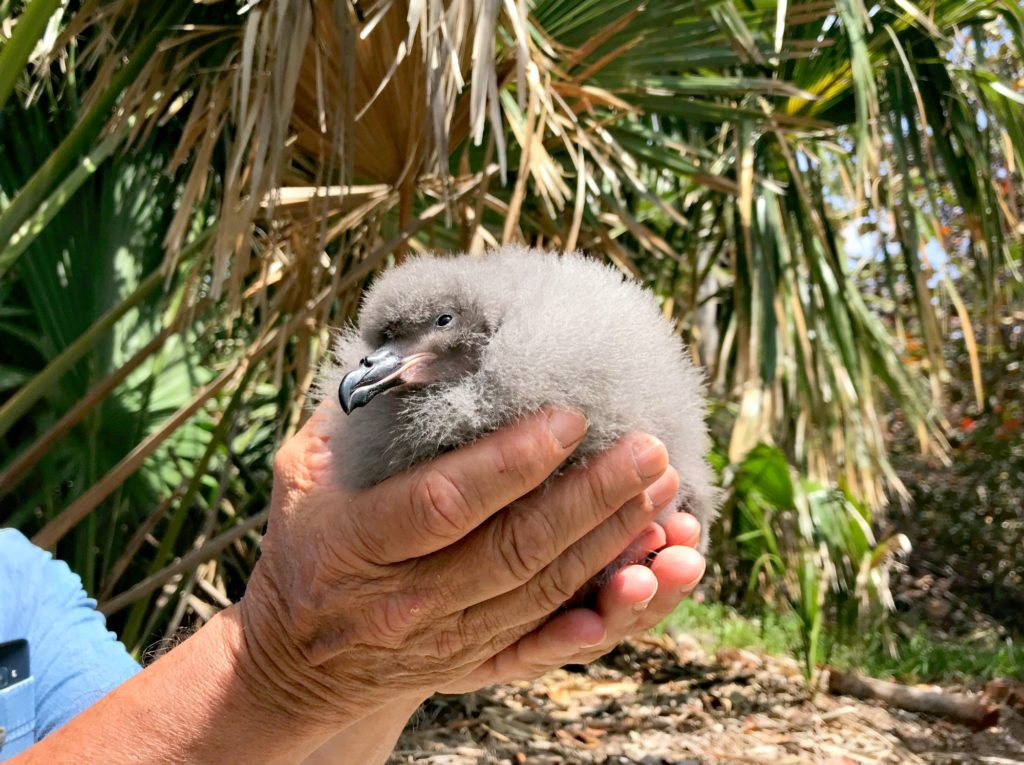
“Spirit is only three weeks old, and looks to be at a good healthy size today,” Jeremy continues in a hushed voice before pulling out his measuring and other documentation equipment.
He prepares what looks like a small linen sack, and we gasp quietly as he stuffs the baby bird inside it, loosely cinching the top of the bag. Acknowledging our startled reactions, Jeremy calmly explains that the chick isn’t afraid. He weighs the bird quickly and then takes it out of the bag, holding it gently in the palm of his hand once more. He then outstretches the chick’s tiny wing and measures the length, noting his findings in a tiny notebook as he works.
Jeremy moves slowly from one nest to the next, holding and measuring the chicks, and then putting them back into their underground burrows. When he’s finished with the last one, he stands up and waves to us to follow him out of the area.
Far enough away to talk in a regular tone, we all begin chatting about the Cahow chicks.
“When my four-year-old first saw a Cahow chick up close, she said that it looked like it was made of cotton candy cashmere,” shares JP. We all laugh in agreement. We’ve just had a close encounter with the Cahow, one of the rarest seabirds on Earth, and the experience has left us feeling giddy.
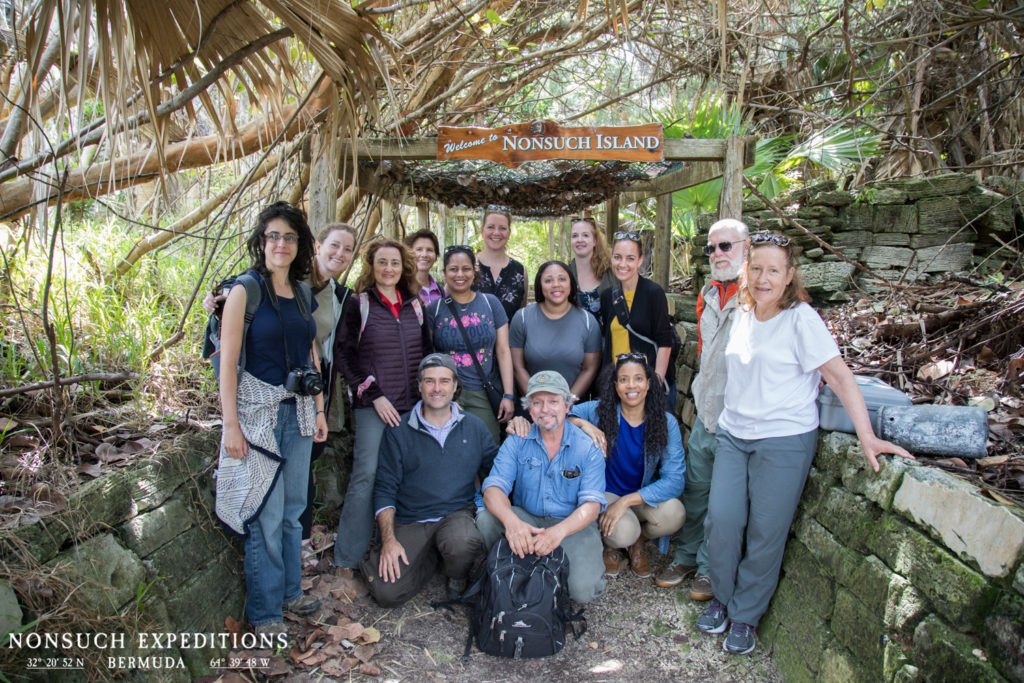
What’s next for Nonsuch Island? A brand new holographic approach to conservation has recently been introduced. Think of holography as the next generation of wildlife cams—a technology that has been spectacularly successful in getting folks fired up about owls, raptors, and other wildlife at nesting and roosting sites. Holograms take the viewing experience to a whole new level. Instead of watching from afar, as with wildlife cams, the holographic experience makes you feel right there. And that’s essential with species like the Black-capped Petrel, which, realistically, will not be encountered in the wild by most people for the foreseeable future. Making the connection is powerful for conservation, and the holographic approach offers considerable promise toward that goal.
The details are technical, but the basic concept is straightforward: In engaging a hologram, the viewer enjoys the eerie, real-time, 3D experience of “being there” with the subject. And that’s especially impressive in the case of a Cahow chick, sequestered in a burrow in complete darkness, hundreds to thousands of miles away. The high-tech video rig, installed prior to translocation, doesn’t disturb the chick at all.
Holographer Alex Hornstein walks us through the setup and maintenance of this impressive technology in an easy-to-follow online article (tinyurl.com/petrel-hologram) that features footage of the animated hologram. Alex cautions that wildlife holography is still in the proof-of-concept stage, but the promise for galvanizing interest in birds and nature clearly is there.
Meanwhile, Jeremy and his dedicated crew continue their work. It seems unlikely that the Bermuda Petrel will ever recover to such numbers as were established on Bermuda four-plus centuries ago. Nevertheless, conservation scientists are optimistic about sustained, if slow and steady, population increases—delighting both Bermudans themselves and visiting birders on ships at sea.
NOTE: This story was originally published in Birding Magazine (American Birding Association) – October 2019 Issue
